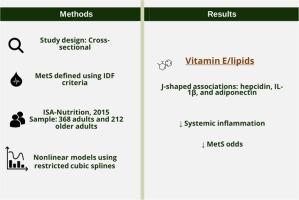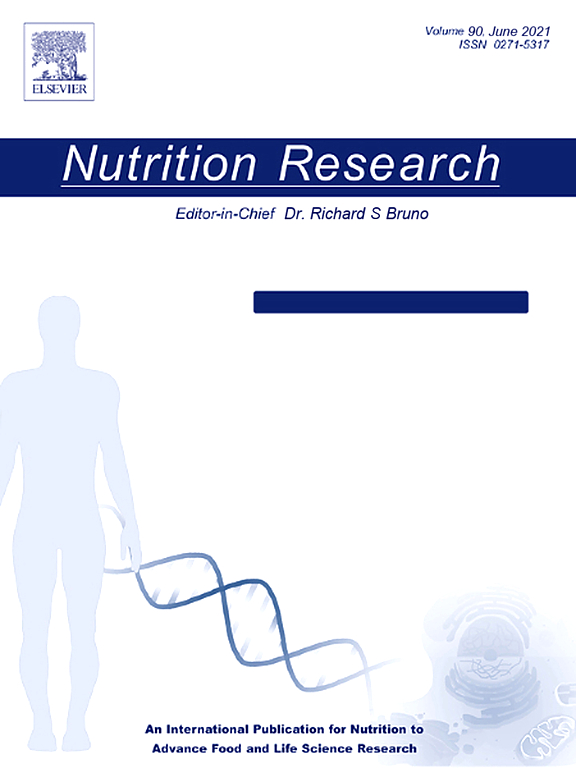Vitamin E is associated with inflammatory biomarkers and metabolic syndrome: insights from a population study
IF 3.1
3区 医学
Q2 NUTRITION & DIETETICS
引用次数: 0
Abstract
Vitamin E is a potent antioxidant with anti-inflammatory properties and has been proposed as a promising agent in mitigating conditions associated with metabolic syndrome (MetS). We hypothesize that vitamin E is inversely associated with inflammatory biomarkers and low-grade systemic inflammation while showing a direct association with anti-inflammatory biomarkers. Additionally, we hypothesize that vitamin E will also be inversely associated with the risk of developing MetS. This population-based, cross-sectional study used data from the 2015 ISA-Nutrition survey, which included 368 adults and 212 older adults residing in urban São Paulo. Plasma vitamin E concentration was measured using high-performance liquid chromatography, and MetS was diagnosed based on International Diabetes Federation criteria. Biochemical and anthropometric parameters were assessed using standardized protocols. Restricted cubic spline regression models were applied to evaluate nonlinear associations between vitamin E, inflammation, and MetS. In the linear association between IL-6 and vitamin E, there is an interaction with HDL-c. Our findings also revealed a nonlinear J-shaped association between vitamin E and hepcidin (P < .0001), IL-1β (P < .0001), and adiponectin (P < .001), as well as an inverse association with low-grade systemic inflammation (P < .05). Additionally, vitamin E demonstrated a nonlinear association with MetS (P < .01). These results suggest that vitamin E may play a protective role in modulating inflammation and MetS within this specific urban population. Understanding the interactions between vitamin E, inflammation, and MetS risk is essential for developing prevention and dietary management strategies. Future research should explore the underlying mechanisms and assess optimal vitamin E intake to support metabolic health.

维生素E与炎症生物标志物和代谢综合征有关:来自人群研究的见解
维生素E是一种有效的抗氧化剂,具有抗炎特性,被认为是缓解代谢综合征(MetS)相关疾病的有希望的药物。我们假设维生素E与炎症生物标志物和低度全身性炎症呈负相关,而与抗炎生物标志物直接相关。此外,我们假设维生素E也会与患MetS的风险呈负相关。这项以人口为基础的横断面研究使用了2015年isa营养调查的数据,其中包括居住在圣保罗市区的368名成年人和212名老年人。采用高效液相色谱法测定血浆维生素E浓度,并根据国际糖尿病联合会的标准诊断MetS。采用标准化方案评估生化和人体测量参数。限制三次样条回归模型用于评估维生素E、炎症和MetS之间的非线性关联。在IL-6和维生素E之间的线性关联中,存在与HDL-c的相互作用。我们的研究结果还揭示了维生素E和hepcidin之间的非线性j形关联(P <;.0001), IL-1β (P <;.0001),脂联素(P <;.001),以及与低度全身性炎症呈负相关(P <;. 05)。此外,维生素E显示出与MetS的非线性关联(P <;. 01)。这些结果表明,维生素E可能在调节这一特定城市人群的炎症和MetS方面发挥保护作用。了解维生素E、炎症和MetS风险之间的相互作用对于制定预防和饮食管理策略至关重要。未来的研究应该探索潜在的机制,并评估最佳的维生素E摄入量,以支持代谢健康。
本文章由计算机程序翻译,如有差异,请以英文原文为准。
求助全文
约1分钟内获得全文
求助全文
来源期刊

Nutrition Research
医学-营养学
CiteScore
7.60
自引率
2.20%
发文量
107
审稿时长
58 days
期刊介绍:
Nutrition Research publishes original research articles, communications, and reviews on basic and applied nutrition. The mission of Nutrition Research is to serve as the journal for global communication of nutrition and life sciences research on diet and health. The field of nutrition sciences includes, but is not limited to, the study of nutrients during growth, reproduction, aging, health, and disease.
Articles covering basic and applied research on all aspects of nutrition sciences are encouraged, including: nutritional biochemistry and metabolism; metabolomics, nutrient gene interactions; nutrient requirements for health; nutrition and disease; digestion and absorption; nutritional anthropology; epidemiology; the influence of socioeconomic and cultural factors on nutrition of the individual and the community; the impact of nutrient intake on disease response and behavior; the consequences of nutritional deficiency on growth and development, endocrine and nervous systems, and immunity; nutrition and gut microbiota; food intolerance and allergy; nutrient drug interactions; nutrition and aging; nutrition and cancer; obesity; diabetes; and intervention programs.
 求助内容:
求助内容: 应助结果提醒方式:
应助结果提醒方式:


